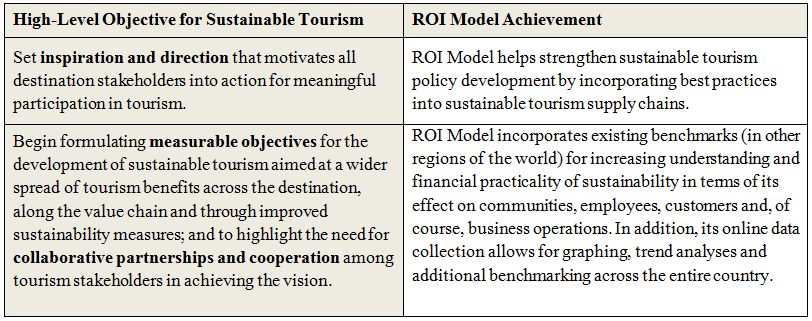The sustainability of tourist destinations is emerging as a key factor for their ability to maintain or build a strong reputation and a competitive brand. This calls for investment in measures aimed at ensuring sustainable practices. The easiest (perhaps only?) way to unlock such investment and financial support is to be able to demonstrate the economic value of (pro)actively making a destination more sustainable. But how to measure the return on investment of sustainability in destinations? Irene Lane has answers.
The business case of destination sustainability
We’ve all heard this claim – Travelers crave responsible hotel and tour options that are socially responsible, environmentally conscious, and economically beneficial to local communities.
However, even with all the surveying and statistics that back up this claim, the tourism industry has been reticent to ingraining sustainability into their operations. Why is that? One reason is because there is no reliable benchmarking data on the exact economic effect that incorporating sustainability will have on a destination.
The fact is that destinations have to make marketing and investment decisions on a regular basis. Whether it’s the development of new tax incentives, public policies or new tourism experiences that will capture the imagination (and wallets) of travelers, investments are constantly occurring.
Tourism destinations have to prioritize strategies so that stakeholders understand, beyond reading the occasional anecdote about another destination’s experience, the actual return on investment (ROI) of sustainability.
Up to now, my research has shown that if ROI was even calculated, it was based on capital investments made into sustainable operations. In other words, projects such as renewable energy, water conservation, waste management, food and beverage sourcing were what was considered sustainable investments.
However, the consistent issue with this approach was that ROI, calculated under those parameters, was negative for at least two years and in some cases up to five years. Hence, as a destination manager, it was of no surprise that stakeholders did not want to wait two years or more to break even on their sustainable investments because other investments could yield higher returns more quickly.
There is a flaw in how ROI of sustainability in destinations used to be calculated. It was not holistic. Just looking at operational investments missed up to 40% of the calculation.
Specifically utilizing an environmental scorecard approach for measuring ROI, I built upon these operational elements by:
- Collecting existing benchmarking data,
- Expanding the model to include applicable investments, savings and incremental revenue opportunities in sustainability to employees, communities and customers,
- Adding additional data such as destination-specific household multiplier effects and productivity rates,
- Attaching a weighted impact to each component.
As a result, the ROI model compiled actionable information about the Operational, Community, Customer, and Employee ROI elements that affect sustainable tourism. In addition, the data could be segmented by tourism type (i.e. accommodations vs. tour activity providers).
Measuring sustainability impact: how the ROI model works
Tourism businesses are asked to input online both quantitative data (found on financial statements) and qualitative/subjective data concerning their perspectives about sustainability. Once the data is fed into the model, each participating company is provided with a personalized 5 Year ROI Dashboard Outlook along with specific recommendations for increasing its ROI, based on best practices.
Then, the results for each individual participant are aggregated at a destination level to reveal both the low-hanging fruit opportunities and the strategic policy objectives which stakeholders can pursue so that optimal results can be achieved.
As an example, a study commissioned by Failte Ireland showed that (for the participants in the study) while Operations ROI remains negative for at least five years, once accounting for the additional investments toward local communities, employees and customers, it more than makes up for difference netting to a positive ROI of 1557 in Year 1.

Then, for multi-day guiding companies, although at a lower rate than for accommodations, they experienced an overall positive ROI of 355 in Year 1.

After analyzing the results, the data also revealed that for both accommodations and guiding companies, the triple bottom line ROI driver for the destination (Ireland) was providing clear and direct information to customers about sustainability.
Essentially, it was the true strategic partnership potential of sustainability that was missing, and, just as the commissioned study revealed, when these parameters are included and weighted appropriately, the ROI calculation shows an entirely different portrait.
With this ROI model, and for the first time, tourism business in Ireland were able to:
- Conduct self-assessments against sustainability standards,
- Receive a 5 Year ROI outlook of how specific investments affect the bottom line,
- Lower financial risk,
- Continuously monitor ROI targets,
- Prioritize sustainability investments.
Applicability of ROI model to destinations
While surveying methods are one key to achieving a baseline understanding of the kind of visitors to your destination, it is also just as important for destinations to utilize financial modeling to calculate the economic baseline of tourism, as well as understand the effect of sustainability on the bottom line.
Then, as the core strategies for destinations are implemented, tourism boards and communities can better plan for the changes that social, economic and environmental sustainability will bring, including the potential development of a national certification scheme.

Concluding thought
As H. James Harrington, who originated IBM’s internal benchmarking procedure and developed the Five Pillars of Organizational Excellence once said,
“Measurement is the first step that leads to control and eventually to improvement. If you can’t measure something, you can’t understand it. If you can’t understand it, you can’t control it. If you can’t control it, you can’t improve it.”
Let’s make sustainable, responsible tourism more insightful for all!
About Irene Lane
 Irene is a green travel expert who has written and spoken extensively about eco-certifications in the travel industry and how families can choose vacations that support communities socially, economically and environmentally. She is the founder of Greenloons, which provides responsible travel tips and information as well as a carefully curated collection of green travel experiences for families. Irene is the only person in the United States who can certify a green travel destination under the internationally accredited Biosphere certification.
Irene is a green travel expert who has written and spoken extensively about eco-certifications in the travel industry and how families can choose vacations that support communities socially, economically and environmentally. She is the founder of Greenloons, which provides responsible travel tips and information as well as a carefully curated collection of green travel experiences for families. Irene is the only person in the United States who can certify a green travel destination under the internationally accredited Biosphere certification.
Follow Irene on Twitter and Google+.
Enjoyed this post by Irene Lane on how to measure the return on investment of sustainable tourism in destinations? Share and spread the word!


